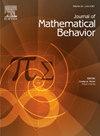Stage 3 high school students’ generalization of a cubic identity
IF 1.7
Q3 EDUCATION & EDUCATIONAL RESEARCH
引用次数: 0
Abstract
This paper reports on one study in a series of design research studies that have taken as a guiding design principle that combinatorial and quantitative reasoning can serve as a constructive resource for high school students to establish algebraic structure between a polynomial and its factors. Within this framing, we report on an interview study with eight 10th-12th grade students whose purpose was to investigate their progress towards generalization of the cubic identity . The students worked on this generalization by solving cases of a 3-D combinatorics problem and representing their solutions using 3-D arrays. Findings include the identification of how differences in students’ combinatorial reasoning impacted their reasoning with 3-dimensional arrays and their progress towards a general statement of the cubic identity.
第三阶段高中生对三次恒等式的泛化
本文报道了一系列设计研究中的一项研究,该研究将组合和定量推理作为指导设计原则,可以作为高中生建立多项式与其因子之间代数结构的建设性资源。在此框架内,我们报告了对8名10 -12年级学生的访谈研究,其目的是调查他们在三次恒等式(x+1)3=1∙(x3)+3∙x2∙1+3∙x∙12+1∙(13)的泛化方面的进展。学生们通过解决一个三维组合问题的案例,并使用三维数组表示他们的解决方案,来研究这种泛化。研究结果包括确定学生组合推理的差异如何影响他们对三维数组的推理以及他们对立方恒等式的一般陈述的进展。
本文章由计算机程序翻译,如有差异,请以英文原文为准。
求助全文
约1分钟内获得全文
求助全文
来源期刊

Journal of Mathematical Behavior
EDUCATION & EDUCATIONAL RESEARCH-
CiteScore
2.70
自引率
17.60%
发文量
69
期刊介绍:
The Journal of Mathematical Behavior solicits original research on the learning and teaching of mathematics. We are interested especially in basic research, research that aims to clarify, in detail and depth, how mathematical ideas develop in learners. Over three decades, our experience confirms a founding premise of this journal: that mathematical thinking, hence mathematics learning as a social enterprise, is special. It is special because mathematics is special, both logically and psychologically. Logically, through the way that mathematical ideas and methods have been built, refined and organized for centuries across a range of cultures; and psychologically, through the variety of ways people today, in many walks of life, make sense of mathematics, develop it, make it their own.
 求助内容:
求助内容: 应助结果提醒方式:
应助结果提醒方式:


